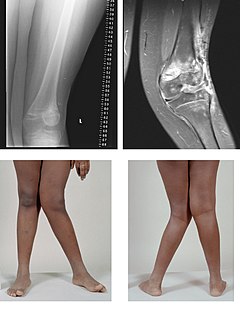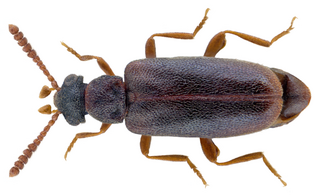
Convolvulaceae, known commonly as the bindweed or morning glory family, is a family of about 60 genera and more than 1,650 species of mostly herbaceous vines, but also trees, shrubs and herbs, and also including the sweet potato and a few other food tubers.

A bunion, also known as hallux valgus, is a deformity of the joint connecting the big toe to the foot. The big toe often bends towards the other toes and the joint becomes red and painful. The onset of bunions is typically gradual. Complications may include bursitis or arthritis.

Genu valgum, commonly called "knock-knee", is a condition in which the knees angle in and touch each other when the legs are straightened. Individuals with severe valgus deformities are typically unable to touch their feet together while simultaneously straightening the legs. The term originates from the Latin genu, 'knee', and valgus which actually means 'bent outwards', but in this case, it is used to describe the distal portion of the knee joint which bends outwards and thus the proximal portion seems to be bent inwards. For citation and more information on uses of the words Valgus and Varus, see varus deformity.

A varus deformity is an excessive inward angulation of the distal segment of a bone or joint. The opposite of varus is called valgus. EX: Varus deformity results in a decreased Q angle of the knee joint.

A valgus deformity is a condition in which the bone segment distal to a joint is angled outward, that is, angled laterally, away from the body's midline. The opposite deformation, where the twist or angulation is directed medially, toward the center of the body, is called varus. Common causes of valgus knee in adults include arthritis of the knee and traumatic injuries.

Märjamaa Parish is an Estonian municipality located in Rapla County. It had a population of 7,015 and an area of 871.62 km² (336.54 mi²). Märjamaa Parish was the biggest municipality in Estonia by area.
Pigeon toe, also known as in-toeing, is a condition which causes the toes to point inward when walking. It is most common in infants and children under two years of age and, when not the result of simple muscle weakness, normally arises from underlying conditions, such as a twisted shin bone or an excessive anteversion resulting in the twisting of the thigh bone when the front part of a person's foot is turned in.

Valgus is a genus of beetles. Most described species are found in Asia, with some reaching into northern Africa and Europe, and three species native to the New World. One species is found in South Africa.

Neotinea tridentata, the three-toothed orchid, is a species of orchid found in southern Europe from Spain to Turkey; northwards to the Crimea, Poland and Germany. This orchid favours grassy places, woodland, scrub and maquis.

Phileurus truncatus, Triceratops Beetle, is a species of beetle of the family Scarabaeidae.

Valgus canaliculatus is a species of scarab beetle in the family Scarabaeidae. It is found in North America.
Valgus californicus is a species of scarab beetle in the family Scarabaeidae. It is found in Central America and North America.

Vanonus is a genus of ant-like leaf beetles in the family Aderidae. There are about 16 described species in Vanonus.
Valgus seticollis is a species of scarab beetle in the family Scarabaeidae. It is found in North America.

Anisocentropus is a genus of caddisflies in the family Calamoceratidae. There are more than 60 described species in Anisocentropus.

Phileurus is a genus of rhinoceros beetles in the family Scarabaeidae. There are more than 20 described species in Phileurus.

Cimolus is a genus of leaf-footed bugs in the family Coreidae. There are at least four described species in Cimolus.
Trischidias exigua, the trischidias exiguus, is a species of typical bark beetle in the family Curculionidae. It is found in North America.

Hypselonotus punctiventris, the spot-sided coreid, is a species of leaf-footed bug in the family Coreidae. It is found in Central America and North America.















